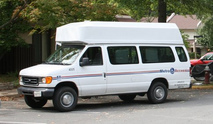Metro faces big budget gap even with a fare hike
Next year will certainly be a challenging year for Metro. According to Metro’s preliminary report, even after an inflationary fare increase of 4-6%, and continued deferral of preventive maintenance, Metro’s supporting jurisdictions would still be required to chip in almost 20% more than last year’s budget ($107M). Since such a large jurisdictional subsidy increase is almost certainly not going to happen in this budget climate, we will likely be looking at a much larger fare increase as well as debates over service cuts. The Post discusses this further.
Fortunately, the Board has a lot more time to contemplate budget-balancing measures this time around. Last year, the Board ended up with a very compressed schedule, forcing the jurisdictions to come up with budget-balancing service cuts for non-regional Metrobus routes only. Under pressure from riders, the Board limited the cuts while funding the remaining gap through borrowing, increases in subsidies, and administrative cost reductions.
What’s driving this deficit? In short, higher costs and lower revenues.
Due to contractual obligations, Metro needs to pay its workers about 3% more than last year, from promotions as well as cost of living increases. That’s about $20M of the gap.
The cost of Metro’s pension plan, health care (retirees and current workers) and other benefits contribute about $33M to the gap. Without more information about Metro’s union agreements, it’s hard to say much more about these issues.
MetroAccess, WMATA’s paratransit service for persons with disabilities, has been increasing in cost rapidly this past decade, up to almost $100M per year in costs, and contributing $19.7M to the budget gap. Because paratransit fares are limited by law to double the equivalent fare by transit, very little of this cost is paid by riders, typically 5-6%. This budget item is expected to grow as the population ages and riders from other jurisdictions choose to use MetroAccess as opposed to services in their home jurisdiction. For example, passenger trips in 1998 were about 250,000, while budgeted trips in 2009 were 1.8 million and are projected to grow to 2.5 million in 2011. In the meantime, MetroAccess expenses in 1998 were about $10M, in 2009 were $78.5M, and in 2011 are expected to be $98.6M.
The costs mentioned above are structural. Without changes in Metro’s employee compensation agreements and in the way MetroAccess is delivered, those budget items will increase every year for the foreseeable future. Increases in ridership, fares, and jurisdictional subsidies should be structured to provide for a reasonable amount of growth in employee compensation and contracted paratransit service.
Energy costs continue to increase, contributing about $10M to the budget gap. This budget item is subject to fluctuations in the energy market.
Revenues: Metro calculates that ridership will grow about 1% from last year after accounting for the effect of a fare increase. Combined with a 4-6% fare increase, Metro calculates that about $44M in new revenue will be available next year. However, all of this increase in revenues is wiped out due to a drop in advertising and other revenue.
Coming up, where Metro could save money and what a fare increase proposal could look like.

